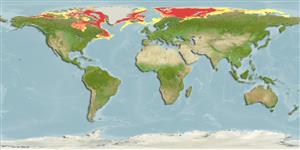Anthozoa |
Actiniaria |
Hormathiidae
Environment: milieu / climate zone / depth range / distribution range
Ecology
Sessile; depth range 6 - 1448 m (Ref. 78738). Polar; 82°N - 35°N, 145°W - 167°E
Arctic and Northern Atlantic: from Camden Bay, south to Cape Hatteras, North Carolina, north to Svalbard and east to Siberian waters. Temperate to polar.
Length at first maturity / Size / Weight / Age
Maturity: Lm ? range ? - ? cm
Solitary (Ref. 2377). Abundant in sublittoral banks and shallow seas (Ref. 119529).
Life cycle and mating behavior
Maturity | Reproduction | Spawning | Eggs | Fecundity | Larvae
Members of the class Anthozoa are either gonochoric or hermaphroditic. Mature gametes are shed into the coelenteron and spawned through the mouth. Life cycle: The zygote develops into a planktonic planula larva. Metamorphosis begins with early morphogenesis of tentacles, septa and pharynx before larval settlement on the aboral end.
Piepenburg, D., N.V. Chernova, C.F. von Dorrien, J. Gutt, A.V. Neyelov, E. Rachor, L. Saldanha and M.K. Schmid. 1996. (Ref. 2952)
IUCN Red List Status (Ref. 130435)
CITES status (Ref. 108899)
Not Evaluated
Not Evaluated
Threat to humans
Human uses
| FishSource |
Tools
More information
Age/Size
Growth
Length-weight
Length-length
Morphology
Larvae
Abundance
Internet sources
Estimates based on models
Price category
Unknown.
